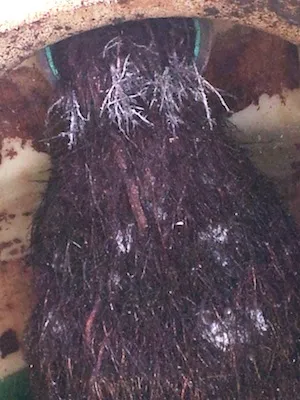From inlet and outlet baffles
Where the pipe meets the concrete of the tank is another place through which roots can sneak in. Excavating the entry point, cutting the roots and re-sealing the area are the best solution.
From the absorption area
The pipe in your septic system’s absorption area has holes to allow the effluent to seep into the trenches. Roots can enter through these holes and infiltrate the absorption area (the photo at right is of a 10 year-old system). Rootering may allow for temporary relief, but roots usually grow back.
Be aware — but not alarmed
Plenty of septic systems can remain functional even with roots in the absorption area. My septic system is 29 years old (past the average life of approximately 25 years), and I have many large oak and cedar trees in close proximity to my tank and drainfield. My tank does not contain any roots, but there are likely roots infiltrating the drainfield pipes that I cannot see, but they are not to the point of causing my system to fail.
Roots can grow back even if they are removed and the entrance points have been sealed. Keeping an eye on those areas to catch any root growth early is recommended. In some cases, tree removal may be necessary if root infiltration is causing a problem.
If you are considering planting trees, avoid planting new trees near your septic system to prevent problems in the future.
Routine septic pumpings are critical
Pumping your septic tank on a regular basis can catch root infiltration in the tank at the early stages — before it gets out of control. Not only can you nip a first-time invasion in the bud, your septic pumper will be able to monitor root re-growth.
Need to schedule a pumping? Give us a call at 210.698.2000 (San Antonio) or 830.249.4000 (Boerne) or contact us online today.
For 86+ years, Van Delden Wastewater Systems has withstood the test of time as the leading Wastewater System company, providing San Antonio, Boerne, and the surrounding Texas Hill Country with services you can count on now and in the future.
Call us for any of your wastewater systems needs and let our professionals help you with your septic installation and maintenance requirements: (210) 698-2000 (San Antonio) or (830) 249-4000 (Boerne).






